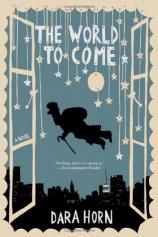The World to Come
Review
The World to Come
Fiction based on real, recognizable and historic personages can be rather tricky. Is the fiction retelling their stories, and if so, why? How much is real and how much is embellished? Why does the author use these figures instead of inventing her own? And, most importantly, how believable is this fictional account of these very real people? Novelist Dara Horn tackles these issues in her ambitious and well-intentioned second book, THE WORLD TO COME. Horn's challenge is complicated further by her use of the life and work of a particularly enigmatic Yiddish writer, Der Nister ("the Hidden One"), as well as the life and work of Jewish painter Marc Chagall.
THE WORLD TO COME is a novel of stories. And stories within stories and the intersection of all these stories. It is also about loss, possibility, meaning and potentiality. Benjamin Ziskind, former child prodigy and current quiz writer for "American Genius," is newly divorced and has just lost his mother. He is depressed and a bit angry; when he finds himself staring at a painting by Marc Chagall that used to hang in his family's home, he instinctively (and quite easily) steals it from the museum.
We are then taken back in time to the Jewish Boys' Colony in Malakhovka, Russia in 1920. Boris Kulbak, an orphan, is about to come into possession of "Study for Over Vitebsk," which his grandson will reclaim over 70 years later. It is in Malakhovka that Horn introduces us to her versions of Chagall and Der Nister. One will go on to become the famous and acclaimed painter, and one will remain a mysterious writer of strange and folklorish Jewish tales. We follow the painting and the Kulbak-Ziskind family over three generations. We are in fact introduced to the fourth generation --- Benjamin's twin sisters' soon-to-be-born son, Daniel, who resides in The World To Come, at the end of the novel.
In addition to the family, Horn follows the stories the family tells and the painting as it appears, disappears and appears again in their lives. Horn seems to want to say that Benjamin is at the center of the tale. But, in reality, the tale is at the center of the tale. In many ways THE WORLD TO COME is about storytelling itself and the power of personal, familial and cultural myth. The novel swings between the past and present, and between the real and fantastical. Occasionally Horn is too fanciful, to the point of distraction. In her prose Horn is --- as she has I.L. Peretz say of Der Nister --- "too indulgent." There are no real compelling characters in the novel who you want to cheer for, except for the relatively minor character of Boris.
There is some effective tension in the novel that releases into a deep sadness when Boris is taken away from his daughter. But often the book is too wordy and clever to feel emotionally real. And make no mistake about it --- THE WORLD TO COME is clever. There are some interesting uses of Jewish folklore and myth, and her exploration on meaningfulness (or meaninglessness) being in the proverbial eyes of the beholder is worthwhile, as is her examination of originality and plagiarism. However, the fantastical vision of The World To Come at the end of the novel coupled with the open-ended conclusion and some obvious contrivances make this a bit unsatisfying to read.
Dara Horn surely picked Der Nister and Chagall to appear in her novel for good reason. Each represents a different possibility or outcome for 20th century Jewish artists in Russia (and elsewhere). One stands as a success story, while the other has all but disappeared into the archives of Yiddish literature. What connection does each man have to her story other than as a vehicle to move the painting and the old Yiddish texts to the hands of Benjamin Ziskind? Here, Horn is less sure.
Often beautiful, witty and sophisticated, in the end THE WORLD TO COME lacks a central theme or point and often feels hollow.
Reviewed by Sarah Rachel Egelman on January 24, 2011
The World to Come
- Publication Date: October 17, 2006
- Genres: Fiction
- Paperback: 336 pages
- Publisher: W. W. Norton & Company
- ISBN-10: 0393329062
- ISBN-13: 9780393329063










